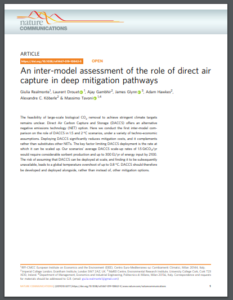Full Title: An inter-model assessment of the role of direct air capture in deep mitigation pathways
Author(s): Giulia Realmonte, Laurent Drouet, Ajay Gambhir, James Glynn, Adam Hawkes, Alexandre C. Köberle, & Massimo Tavoni
Publisher(s): Nature Communications
Publication Date: July 22, 2019
Full Text: Download Resource
Description (excerpt):
The feasibility of large-scale biological CO2 removal to achieve stringent climate targets remains unclear. Direct Air Carbon Capture and Storage (DACCS) offers an alternative negative emissions technology (NET) option. Here we conduct the first inter-model comparison on the role of DACCS in 1.5 and 2 °C scenarios, under a variety of techno-economic assumptions. Deploying DACCS significantly reduces mitigation costs, and it complements rather than substitutes other NETs. The key factor limiting DACCS deployment is the rate at which it can be scaled up. Our scenarios’ average DACCS scale-up rates of 1.5 GtCO2/yr would require considerable sorbent production and up to 300 EJ/yr of energy input by 2100. The risk of assuming that DACCS can be deployed at scale, and finding it to be subsequently unavailable, leads to a global temperature overshoot of up to 0.8 °C. DACCS should therefore be developed and deployed alongside, rather than instead of, other mitigation options.
